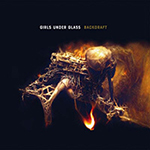 We proceed to listening after appropriate break-in and acclimatization. Et voilà. Suddenly Kojak sits next to me on the couch. Lollipop. Glasses. Hat pulled down low over his face. Only the body is missing. I could summon Dieter Bohlen and simulate musical degradation but no, that would lead to a small marital crisis including … best drop it.
We proceed to listening after appropriate break-in and acclimatization. Et voilà. Suddenly Kojak sits next to me on the couch. Lollipop. Glasses. Hat pulled down low over his face. Only the body is missing. I could summon Dieter Bohlen and simulate musical degradation but no, that would lead to a small marital crisis including … best drop it.
Instead we conjure up something smart and wholesome via Qobuz. That's Darkfighter, the new album by Rival Sons. There's currently no other band which combines the blues, Hard and 70s Rock as tightly, joyfully and experimentally as the four Californiacs who don't seem even remotely retro or old-fashioned.
The musicians understand each other like telepathy and had me at hello repeatedly, say on the fabulous "Guillotine" which lives on the constant contrast between quiet and loud passages.

This was an excellent opportunity to test macrodynamics. It's self evident that such a small speaker won't trigger volcano-like eruptions like prominent floorstanders. The One won't rival the far larger and more expensive Audio Note AN-J/LX Hemp [~€6'800 sans stand). No wonder, the J/LX is outright groomed for attack and dynamics. In this regard the One/II is much gentler. It tracks significant voltage swings neither restrained and soft nor emphatically snappy and energetic. It falls somewhere between cozy lava lamp and spiky dog collar to remain in the 1970s. So on the one hand this gave up a little bit of drum 'n' bass power after Rival Sons frontman Jay Buchanan croons "Am I closer to heaven or closer to hell?" and the song thickens. On the other hand, it came across as very fluid and natural.
Max SPL too are limited by design. No surprise there. However, attainable loudness easily eclipsed conversation levels when my McIntosh pushed it. Concerning limited wall clearance—more on that anon—the One reminded me of the €3'100/pr Harbeth P3ESR XD which I reviewed two years ago. That was a sealed box. Despite these differences, the Audio Note shared its specific flair for microdynamics which reproduces the smallest level gradations very precisely. Here too flow (a tad less than the Harbeth) and attack (a tad more) almost balanced each other out. This was evident on the same album's "Rapture". The delicate touches of the acoustic guitar were very clear in the quiet middle section without feeling spot-lit.

 This brings me to resolution and the elaboration of detail. Here the British-Austrian sonic furniture left an excellent impression. During my two months with it, I felt very well-informed and never short on detail. In fact, the flash flood of information was richer than expected from a speaker in this class. During the moody "Backdraft" intro from the eponymous album by Girls Under Glass, many ominous very atmospheric synth pads waft through the room alongside a distorted voice and grating noises.
This brings me to resolution and the elaboration of detail. Here the British-Austrian sonic furniture left an excellent impression. During my two months with it, I felt very well-informed and never short on detail. In fact, the flash flood of information was richer than expected from a speaker in this class. During the moody "Backdraft" intro from the eponymous album by Girls Under Glass, many ominous very atmospheric synth pads waft through the room alongside a distorted voice and grating noises.
I've listened to the track many times over headphones like Focal's Clear MG and my Sonus Faber Olympica Nova 3 speakers. Now I didn't miss a thing with the One/II's detailed imaging. It also managed to track tiny reverberations into even the darkest of corners. This was also due to its high-quality treble which felt very detailed and airy but smooth so without any trace of sharpness or edge. Only when placed much farther into the room did the overall sound seem off-balance so too thin and bright. At just 20cm from the front wall, tonality locked in just as Martin Grennall had predicted!